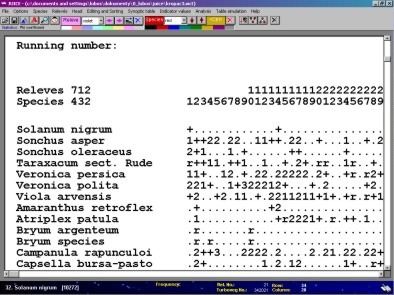The JUICE program is designed as a Microsoft® WINDOWS® application for editing, classification and analysis of large phytosociological tables. This software utilises many functions for easy manipulation of table and header data. The program is optimised for use in association with TURBOVEG software which is the most widespread database program for storing phytosociological data in Europe, even though the data import is also possible from a spreadsheet data format. Basic functions useful for editing and final publishing of phytosociological tables are enlarged on different analysis (Beals smoothing, Ellenberg indicator values, similarity indices, beta-diversity, interspecific associations, diagnostic, dominant and constant species of synoptic tables etc.) and classification using COCKTAIL, TWINSPAN and PC-ORD methods. Easy simulation of artificial data for testing is possible. Export of tables, synoptic tables, headers and different types of analysis (fidelities, species groups, indicator values, synoptic tables, diagnostic species etc.) is created in four data formats: (1) MS-DOS text, (2) Rich text format for word processors (e.g. Microsoft® WORD®), (3) spreadsheet format (e.g. Microsoft® EXCEL®) and (4) the database format (Microsoft® ACCESS®). The program directly supports cooperation with the DMAP mapping package and creates the Cornell condensed files for other classification utilities such as CANOCO or PC-ORD). The JUICE program is continuously developed from 1998 as a freeware application in the group of vegetation science at the Department of Botany, Masaryk University, Brno, Czech Republic. |
|
